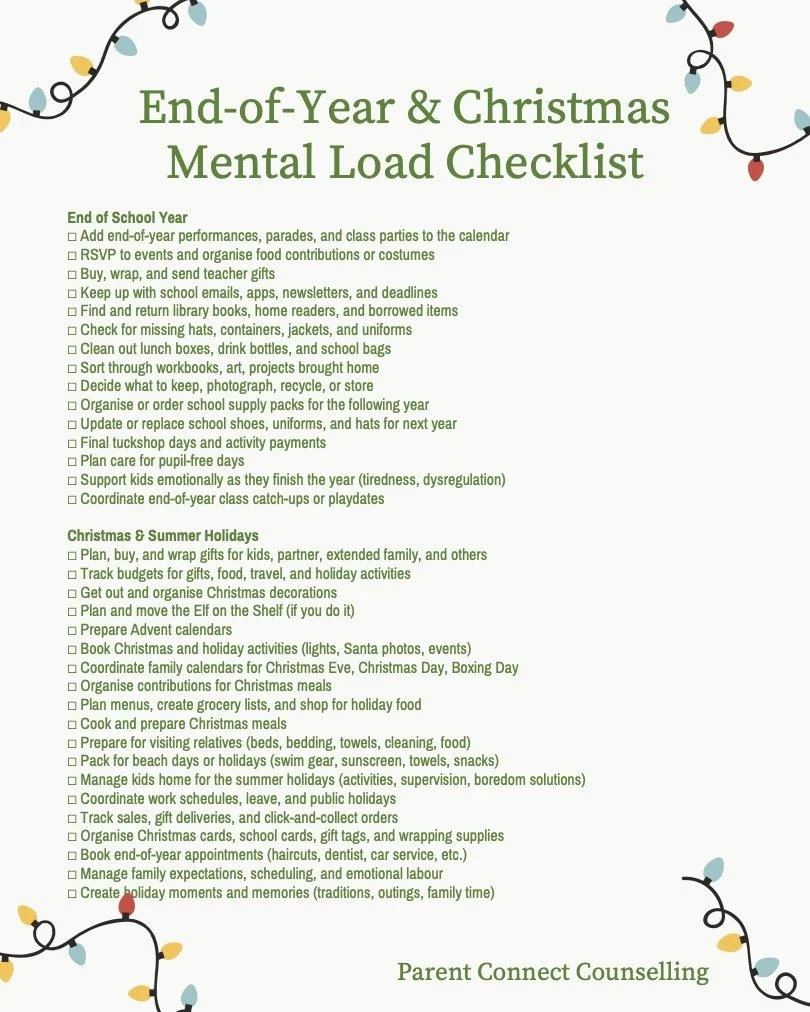Making the Invisible Load Visible: Holiday Checklist for Families
By KJ Bennett, Couples Therapist
As the school year wraps up and the Christmas holidays begin, many parents—especially mums—find themselves carrying an invisible load that grows heavier by the day. It’s a time of year filled with concerts, class parties, book returns, teacher gifts, holiday events, food planning, family logistics, and the emotional labour of holding everyone’s feelings together as the year winds down.
And while these tasks might look small on their own, together they create a mental load that is constant, consuming, and (for many couples) deeply unbalanced.
One of the most important things I talk about in the therapy room this time of year is this:
The mental load cannot be shared if it isn’t visible.
Why Visibility Matters
Mental load is often silent.
Unspoken.
Assumed.
Internal.
One partner—most often the mother—is holding dozens (sometimes hundreds) of micro-tasks and anticipatory thoughts in her mind. She’s tracking school deadlines, Christmas plans, gifts, travel, food, relatives, and routines. And while her partner may be willing, caring, or even helpful, they simply may not see the full picture of what is happening beneath the surface.
That gap between effort and awareness is where resentment grows.
Not because one person is intentionally avoiding responsibility, but because no one can share a load they aren’t aware of.
Step One: Make the Mental Load Visible
I encourage couples to sit down together and look at the full End-of-Year & Christmas Mental Load Checklist. Not as a weapon. Not as evidence of failure. But as a map.
A map of everything that’s been sitting in one person’s mind.
Sitting together with this list brings it out of the shadows. It gives both partners a shared view of what needs to be done and what has already been carried—often quietly—for weeks.
Step Two: Grab Two Highlighters
Each partner chooses a colour. Then:
Highlight what you will take responsibility for
Add anything that fits your family but isn’t on the list
Cross off anything that doesn’t apply this year
This is where couples often say, “Wow, I didn’t realise how much there was.”
And that awareness alone shifts the dynamic.
When the mental load becomes something both partners can see on paper instead of one partner holding it internally, it becomes something that can be shared.
Step Three: Tasks Don’t Magically Divide Themselves
In therapy, I often say:
“Things don’t silently sort themselves out. They sort themselves out when we sit down, roll up our sleeves, and each put out our hands for what we can realistically take on.”
This step is practical and symbolic.
You are intentionally choosing balance.
You are actively preventing resentment.
You are creating a structure where one person doesn’t become the default project manager of family life.
And importantly—this isn’t about splitting everything 50/50.
It’s about making decisions consciously, collaboratively, and with the wellbeing of the family (and each partner) in mind.
The Payoff: Less Resentment, More Connection
A Gentle Reminder
If you’ve been the one carrying this mental load alone, you’re not imagining it.
It is a lot.
It’s valid.
And it makes sense that you’re tired.
If you’re the partner who hasn’t seen the full picture until now, this is an opportunity—not to feel guilty, but to participate more intentionally.
A Final Note from Me
To make this whole process easier, I’ve created a printable checklist for you—one less thing to carry mentally. Use it together in whatever way works best for your family. Reminder the goal isn’t perfection or a 50–50 split; it’s simply to bring the invisible load into the light so it can be shared more intentionally.
And depending on the age of your children, don’t hesitate to bring them onboard too. Some of these tasks can become part of their list—building responsibility, confidence, and a shared sense of family contribution.
If, once everything is visible on paper, you notice feelings of resentment or deeper emotions rising up—please know this is completely normal. When the mental load shifts from silent to spoken, the emotions connected to it often surface too. Sometimes redistributing tasks is enough. Other times the roots run deeper and need attention, understanding, and support.
This is work I do with couples every day, and you’re welcome to reach out if you need guidance navigating the conversations or the feelings that come with them.

